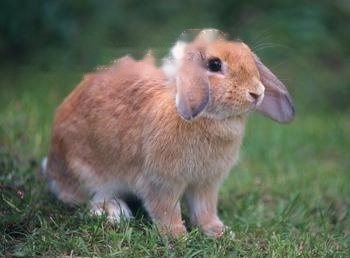
American Mini Lop
American Mini Lop Rabbit, also commonly known as Binny lop, small lop or pygmy lop.
English name: Dwarf Hotot
Personality: Lively, Alert
Origin: Germany
Lifetime: Unknown years
DwarfBegonia Rabbit Variety. Pygmy Begonia rabbits can be divided into two types, one is pure white body color with black eyeliner on the eyes; the other also has black eyeliner, but there are some spots on the white body.
Chinese Name: Dwarf Begonia Rabbit
English Name: Dwarf Hotot
Common Name Aliases: Dwarf Hedart, Dwarf Panda Rabbit
Breeds: Pygmy Begonia rabbits can be divided into two types, one has a pure white body color with black eyeliner on the eyes; the other also has black eyeliner, but there are some spots on the white body.
Origin: Germany
Lively, alert, curious, easy to get along with people, is a very cute breed. Weight: less than 1.36kg, the dwarf Begonia rabbit is petite in size, with an arc shape from the shoulders to the buttocks, the head is large and the ears are short (the ideal length is about 6cm), the eyes of the dwarf Begonia rabbit (5 photos) The pearl is dark brown and the whole body is white , is also pure white and only the hair around the eyes is black, and the ears are not longer than 7cm.
DwarfBegonia is relatively small and is a small petRabbit breed, which is more popular among pet rabbit breeds Yes, the Pygmy Begonia Rabbit has erect ears and white body, only the fur around the eyes is black, very cute and cute.
Dwarf Begonia rabbits can be divided into two types, one is pure white body color with black eyeliner on the eyes; spot. The Pygmy Begonia Rabbit is petite in size, with an arc shape from the shoulders to the buttocks, a large head and short ears (the ideal length is about 6cm), dark brown eyes, white body, also pure white and only the hair around the eyes is black Yes, the ears are no longer than 7cm.
Weight less than 1.36kg. Due to its small size, it is enough to keep it in a small space. If you want to keep it indoors, you can, but pay special attention to wires and furniture, which may be injured.
DwarfBegonia Most of the time is spent in the rabbit cage, so a suitable rabbit cage is very necessary for the Pygmy Begonia rabbit. So, how to choose a rabbit cage for a pygmy crabapple?
The first thing is size and height. Many people think that dwarf crabapple rabbits are not big, but the relatively spacious space is definitely beneficial to their physical and mental health. Generally, 40cm*60cm (inner diameter) is the minimum, no matter what you raise breeds of rabbits. Pygmy Begonia Rabbit likes to stand up, so it must have the necessary height, the minimum is 45~50cm (inner diameter).
The second is the foot pads. What is the bottom of the dog cage? dogs in the cage with the cat I always stand on an iron railing, but rabbit is absolutely No, no matter how big the gap of your bottom net is, whether it is a strip or a square, in a word, the rabbit's feet should not step on the metal grid, which will cause serious skin diseases on the soles of the feet. Pay attention to the professional rabbit cages. It was found that the feet of the pygmy begonia rabbit need to step on the plastic grid. Of course, the foot pads of the plastic mesh can be reconfigured.
There is another factor that is convenient for parents to clean. Professional rabbit cages have perimeters, this is because the dwarf Begonia rabbits are leaning against the cage to urinate. Well, those ball poo will be kicked out of the cage too.
DwarfBegonia 's diet is relatively simple, and many foods cannot be provided to it. The best food is hay, rabbit food and some fresh vegetables and fruits. Moreover, the dwarf crabapple will eat its own feces, so the owner should not be surprised.
rabbits are herbivorous animals, Favorite foods are: carrots, sweet potatoes, cabbage, pumpkin, spinach, cucumber, radish leaves, oranges, bananas, grapes, apples, plantains, dandelions, goose intestines, bean curd, bread, etc. Some foods cannot be eaten in large quantities: corn, peanuts, potatoes, etc. Foods that cannot be eaten: chocolate, coffee, wine, onions, leeks, green onions, garlic, etc.
Special attention should be paid not to have too much water in the food, otherwise it will lead to diarrhea or even death of the rabbit! The food should be washed before feeding, and the water on the surface should be wiped dry before feeding the rabbit. Cooked or frozen food should not be eaten. There is also a granular artificial feed for rabbits on the market, which has the advantages of balanced nutrition and good hardness for teeth. If you are not too expensive, this is also a good food. You can artificially feed the main food, and then provide a little vegetables or weeds.
The digestive system of rabbits is quite long and can account for 10-20% of body weight. In terms of structure, the rabbit has only one stomach, but the position is special, so that the rabbit will not vomit, so when there are gastrointestinal problems, it often shows anorexia. Rabbits are herbivorous animals and need a place for fermentation to decompose food, and the rabbit's cecum becomes the most important place. If you observe the poop of rabbits, there are two kinds of poop, hard and soft. If the amount of fiber is not enough, or the proportion is reduced, the intestinal peristalsis of the rabbit will slow down, and even the bad bacteria in the cecum will grow excessively, and then the rabbit will start to get sick and finally die. It is very important to allow the rabbit to eat an unlimited amount of hay to avoid problems with the digestive tract.